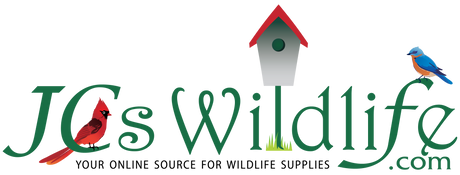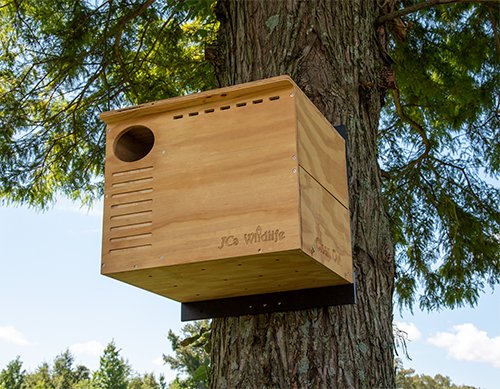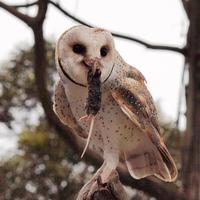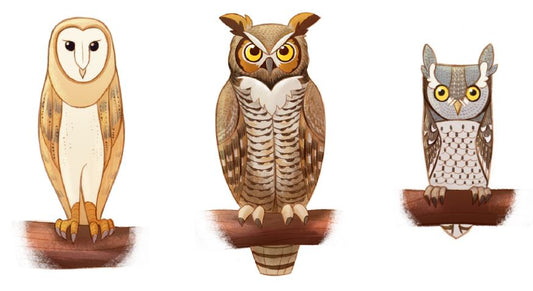-
American Goldfinch (0)
-
American Robin (0)
-
Baltimore Oriole (0)
-
Blue Jay (0)
-
Bluebirds (1)
-
Carolina Wren (0)
-
Chickadee (0)
-
Ducks (0)
-
Starling and House Sparrow (1)
-
House Finch (0)
-
House Wren (0)
-
Hummingbirds (5)
-
Northern Cardinal (1)
-
Northern Mockingbird (0)
-
Nuthatch (0)
-
Owls (3)
-
Tufted Titmouse (0)
-
Woodpeckers (0)
Get to Know Barn Owls and Barn Owl Boxes
If you're looking for more information on Barn Owls, this is the right place to come! The Barn Owl Boxes made by JCs Wildlife are some of our most popular selling houses, and our customer service team has been asked just about every question about the animals and our boxes that can be asked. Since we get so many questions, we decided to put together a separate page all about Barn Owls to help answer any questions that you might have regarding Barn Owls, where to place your nest box, why our barn owl boxes work, and more. We hope you enjoy learning about Barn Owls!
About Barn Owls
Identification
Barn Owls have a white, heart-shaped facial disk, no ear tufts and long legs. The Barn Owl will appear white from below and a golden-brown from above with tiny black specks all over. Their long wings fold beyond the tail and the legs are feathered. The sexes can be distinguished by differences in coloration and weight. Males will usually have whiter breasts with fewer and smaller dark specks. Females are typically heavier and have more and bigger dark specks on them. Chicks are covered with down when born, but 8 to 10 weeks later, they will acquire adult-like plumage.
Reproduction
Barn Owls are are monogamous creatures meaning they only have one mate. They are not aggressive toward other Barn Owls and can nest within a half mile of other pairs. Barn owls are sexually mature at 1 year of age and because they have a short lifespan, they breed only once or twice. Both natural and human-made sites are used for nesting and they are generally used repeatedly by other barn owls throughout the years. Nest sites include tree cavities, barns, abandoned and occupied buildings, and chimneys. Males use a courtship call to show the female the nesting site. Barn Owls do not construct a nest; the eggs are laid in a dark space surrounded by pellets.
The 5 - 11 eggs (average 4-6) are laid every other day. The female incubates the eggs for 30 - 34 days, starting when the first egg is laid. Hatching occurs in the same order as the eggs were laid, so a gradation of ages and sizes can be observed in a brood. In times of scarce food, the older and stronger young have a better chance of survival. The young are fed by both adults for approximately 2 months. The adult male does most of the hunting and feeding.
Reason for Decline
Land use changes, particularly the decrease in the number of farms, have contributed to the decline of this species. Not only has foraging habitat been reduced, but the increased use of rodent poisons has resulted in a smaller food base. Natural nest sites in hollow trees are often limited, and human disturbance of the nest during incubation may cause nest abandonment. One common cause of mortality of young Barn Owls is because of raccoons. Other mortality factors include exposure to harsh weather, electrocution by power lines, Great Horned Owls, and accidental entanglement in farm and industrial machinery.
Commonly Asked Questions
What do Barn Owls sound like?
Barn Owls do not "hoot," they have a raspy scream. While flying, their wingbeats are almost noiseless. Nestlings are quite noisy at night, waiting for their food.
What kind of nesting material do Barn Owls use?
JCs Wildlife provides pine shavings in our nesting boxes to help entice the creatures to our Barn Owl nest boxes. However, Barn Owls are much more used to creating their own nesting material by shredding their own pellets. Pellets include undigested material from that day's prey. The owls cough them up, shred them, and use them for nesting purposes.
How big are Barn Owls?
Barn Owls are comparative to Crows in size. They average 12.6 - 15.8 inches tall, with a 39.4 - 49.2 inch wingspan. They have long legs and short tails. They tend to maintain a crouched position as adults.
North American Barn Owls, found in the US and Canada, are the largest. They are 50% heavier than European Barn Owls, but their leg length is only 25% longer, and their wings are 12% larger.
Where do Barn Owls live?
Barn Owls may be found on every continent except Antarctica, and each species is different. North American Barn Owls, found in the US and Canada, are the largest. They are 50% heavier than European Barn Owls, but their leg length is only 25% longer, and their wings are 12% larger.
You can find Barn Owls roosting in quiet cavities in rocks and trees, or in man-made structures such as barns and silos. Barn Owls have also been found nesting under bridges and overpasses. For hunting, Barn Owls can be found in wide open spaces such as fields and farms.
Nesting sites will often be used season after season, and possibly by different owls. They can have 1 - 3 broods of 2 - 18 eggs.
Will a Barn Owl take off with my pet?
A Barn Owl will probably not take off with your pet, and they will likely not attack when pets or people get close to their nests. However, if a Barn Owl feels that their nesting site is threatened by anything other than another Barn Owl, they can get scared away. They will look for another location and start again. This is especially true in April and May.
Barn Owls are nocturnal animals. Their diet consists mostly of small mammals and the occasional bird. If you have a Barn Owl Box and notice the smell of decomposition, do not worry. They will store their prey in their nest box while they are waiting for their young to hatch. It is not uncommon to see Barn Owls perch on or near the entrance hole of their nest box and toss food in before taking off again.
JCs Wildlife Barn Owl Boxes

Our plywood version of the Barn Owl Box is the one of our best selling JCs Wildlife brand products. This box can be found in vineyards and large farms across the United States due to the natural pest control that Barn Owls can become. This box also features the elliptical shaped entrance hole to help provide extra safety features to protect the owlets from predators like raccoons and Great Horned Owls. No perches exist outside of the box as they could provide convenient perches for predators. A clean out door located at the end of the box allows for easy access to the interior - making cleaning the box a simple task. This also provides an easy access spot to mount a wildlife camera in the box so you can enjoy viewing your owlets during their growth process. The overall design is very similar to the Ultimate Poly Barn Owl Box with the only major difference being that this one is made with plywood. This box is made with exterior grade plywood and treated with natural linseed oil and mineral spirits to help protect the wood. We recommend that no paint or varnish should be applied to the box. Add the exercise platform to make this box even safer!
This box weighs about 45 pounds, so we suggest a team of two when it comes to mounting.
Dimensions: 24" W X 21" D X 19.25" H (roof overhangs box by 2" in front)
XL Barn Owl Box (available in Poly and Plywood)

Our XL Barn Owl Box is perfect if your looking for a huge owl box. This box has two variants: a fully recycled poly lumber box and a plywood body box with a poly roof. The poly lumber material means that this box will never crack, split or fade due to being exposed to the outdoor elements. This Barn Owl Box will last for many years. The entrance hole is elliptical in shape to provide protection from predators including raccoons and Great Horned Owls. Should a predator be able to reach into the box, they will be unable to reach the owl or owlets on the other side of the divider. A door on the end of the box allows for easy access to the interior - making cleaning a simple and quick task. This also provides access to mount a wildlife camera in the box so you can enjoy viewing the young owlets during their growth process. This box design has proven very successful in attracting and providing homes to thousands of owls. Ranchers, farmers, and vineyards have found these useful for natural pest control.
This box comes with the exercise platform for a sense of added security. The platform wraps all the way around this box to create a wrap-around porch for the owls.
Additionally, this XL Barn Owl Box will need to be mounted on a 6" x 6" post that is 16' tall while being secured in 4' of concrete.
Dimensions: 31" H x 33" D X 34.25" W
This box weighs about 65 pounds, so we suggest a team of two when it comes to mounting.
Why do our Barn Owl Nest Boxes work?
Barn Owl Nest Boxes built by JCs Wildlife are based on the design of Steve Simmons and Lee Pauser. Our design is slightly larger. And where previous designs lacked proper ventilation, ours includes ventilation and drainage holes, as well as a partition inside the box. This partition keeps the interior of the box (the owl living space) completely dark and protected from the elements. This prevents overheating in the warmest areas and provides protection in the coldest months. You can find boxes made by JCs Wildlife in orchards, vineyards, farms, schools, universities, and thousands of residence across the US.
Where should I mount my box?
Barn Owls generally prefer open fields and meadows with a plentiful supply of small animals. Owls will generally eat voles, deer mice, house mice, gophers, and small birds. The Barn Owl Box should be placed where there will be a steady population of these animals.
Ensure that the owls have a clear path into and out of the box with no roads, train tracks, wires or trees within 50 - 60 feet of the opening.
For best results, we suggest mounting your Barn Owl Box 12 - 20 feet high on a building exterior, tree or pole as this is the general preference for nesting.
How often should the box be cleaned?
Your Barn Owl Box should be cleaned about once a year when the current residents are not nesting in the box. The coldest month is usually the best month to clean out the box. We would suggest December.
No comments










0 comments